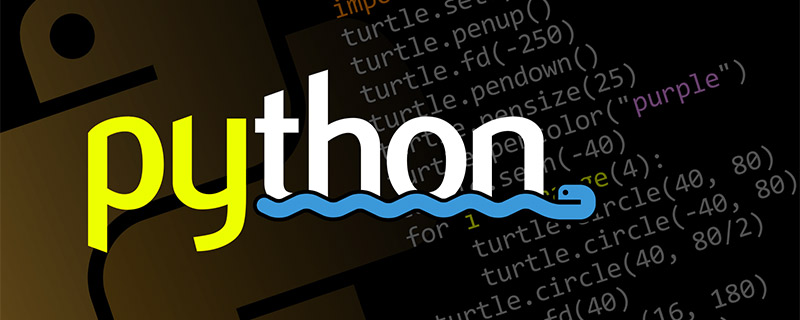
Data analysis refers to the process of analyzing a large amount of collected data using appropriate statistical analysis methods, extracting useful information and forming conclusions, and then conducting detailed research and summary of the data. This process is also a supporting process of the quality management system. In practical terms, data analysis helps people make judgments so that appropriate actions can be taken.
The mathematical foundation of data analysis was established in the early 20th century, but it was not until the emergence of computers that practical operations became possible and data analysis was promoted. Data analysis is a combination of mathematics and computer science.
Recommended courses: Python Tutorial.

#Python Such languages are called scripting languages because they can write short and rough small programs, called scripts. However, this seems to say that Python cannot build rigorous software. In fact, after several years of continuous improvement, Python not only has powerful data processing capabilities, but can also be used to build production systems.
However, because Python is an interpreted language, most Python code is much slower than code in compiled languages (such as C and Java). So in applications that require very little latency, in order to optimize performance as much as possible, it is more worthwhile to use a lower-level and less productive language like C.
For high-concurrency, multi-threaded applications, Python is not an ideal programming language. This is because Python has something called GIL (Global Interpreter Lock), which is a way to prevent the interpreter from A mechanism to execute multiple Python bytecode instructions simultaneously. This is not to say that Python cannot execute truly multi-threaded parallel code, it is just that such code cannot be executed in a single Python process.
3. Python libraries related to data analysis
NumPy
NumPy is the basic package for scientific computing in Python. Provides:
Fast and efficient multi-dimensional array object ndarray;
Functions that directly perform mathematical operations on arrays and perform element-level calculations on arrays;
Linear algebra operations, random numbers Generate;
Tools for integrating C, C, Fortran code into Python, etc.
It is designed for rigorous number processing. It is mostly used by many large financial companies, as well as core scientific computing organizations such as Lawrence Livermore, and NASA uses it to handle some tasks that were originally done using C, Fortran or Matlab.
Pandas
Pandas mainly provides a large number of data structures and functions for processing structured data quickly and conveniently.
Matplotlib
Matplotlib is the most popular Python library for charting data.
IPython
IPython is part of the Python scientific computing standard toolset and an enhanced Python Shell, designed to increase the speed of writing, testing, and debugging Python code. . Mainly used for interactive data processing and data visualization using matplotlib.
SciPy
SciPy is a collection of packages specifically designed to solve a variety of standard problem domains in scientific computing. Mainly includes the following packages:
scipy.integrate: numerical integration routines and differential equation solvers;
scipy.linalg: extends the linear algebra routines and matrix decomposition provided by numpy.linalg Function;
scipy.optimize: function optimizer and root finding algorithm;
scipy.signal: signal processing tool;
scipy.sparse: sparse matrix and sparse linear system Solver;
scipy.special: Wrapper for SPECFUN, a Fortran library that implements many commonly used mathematical functions.
scipy.stats: Standard continuous and discrete probability distributions, various statistical tests, and better descriptive statistics;
scipy.weave: Tools for accelerating array calculations using inline C code .
Python has a huge and active scientific computing community
Python has very mature libraries and libraries in data analysis and interaction, exploratory computing and data visualization. An active community makes python an important solution for data processing tasks. In terms of scientific computing, python has a series of excellent libraries and tools such as numpy, pandas, matplotlib, scikit-learn, ipython, etc. In particular, pandas can be said to have unparalleled advantages in processing medium-sized data and is becoming a popular choice for data processing in various industries. The preferred library for tasks.
python has powerful general programming capabilities
Different from R or matlab, python is not only powerful in data analysis, but also in crawlers, web, automated operation and maintenance and even games It has a wide range of applications in many fields. This makes it possible for the company to use one technology to complete all services, which is conducive to business integration between various technology groups. For example, we use python's crawler framework scrapy to crawl data, then hand it over to pandas for data processing, and finally use python's web framework django to display it to users. This series of tasks can all be completed in python, which can greatly improve the company's technical efficiency. .
Python is the universal language in the era of artificial intelligence
Because data analysis is a very boring thing, but with artificial intelligence, these problems will be solved. Today, when artificial intelligence is booming, python has become the most popular programming language. Thanks to python's simplicity, rich libraries and community, most deep learning frameworks give priority to supporting python language programming. For example, tensorflow, the hottest deep learning framework today, although it is written in C, has the best support for python language.
The above is the detailed content of What is python data analysis. For more information, please follow other related articles on the PHP Chinese website!